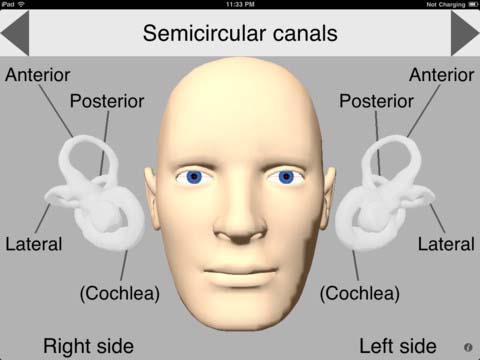Click here for the iTunes link for this application.
Our first free educational and public outreach ‘app’ for iPhone and iPad devices called the aVOR (angular Vestibulo-Ocular Reflex). This project aims to leverage the recent dramatic advances in mobile computing brought by smart-phones and tablets to educate people about inner-ear vestibular (balance) function. These ultra-mobile computing platforms incorporate inertial sensors analogous to the balance sensors of the human inner ear, thus programs (‘apps’) running on these devices can intuitively communicate balance function to a diverse audience, from clinicians to patients.
This educational app (aVOR – angular vestibulo-ocular reflex) utilizes sensors inherent in Apple Incs’ popular iPhone, iPad and Ipod touch devices to demonstrate the function (and pathophysiology) of this basic reflex, which generates eye movements compensatory for head motion. We emphasize how very popular and very useful this app has been for patients – many of whom up to now have had almost no understanding of what is causing their symptoms. aVOR has completely changed that. We have had enormously positive feedback from grateful patients.
The app has since developed as a teaching, training and test tool for the vestibulo-ocular reflex (VOR), vestibular system and its disorders, including BPPV. It demonstrates saccadic eye movements, including those caused by canalithiasis (free-floating particles in the canals), and both functioning and dysfunctional VOR. It shows how BPPV is caused and treated. It also demonstrates how head movement has an automatic influence on eye direction, the impact of dysfunction of the semicircular canals, their size, shape and location in the head, and the causes of nystagmus. The aVOR has now become a common teaching tool with references in new textbooks and public demonstrations.
The free aVOR app has been remarkably popular, with over 50,000 downloads in over 100 countries in 8 languages, demonstrating a considerable audience for this technique.
Contact person for this app: Dr Hamish MacDougall

